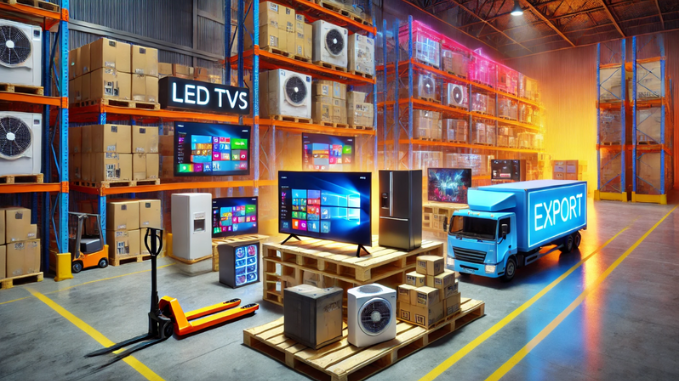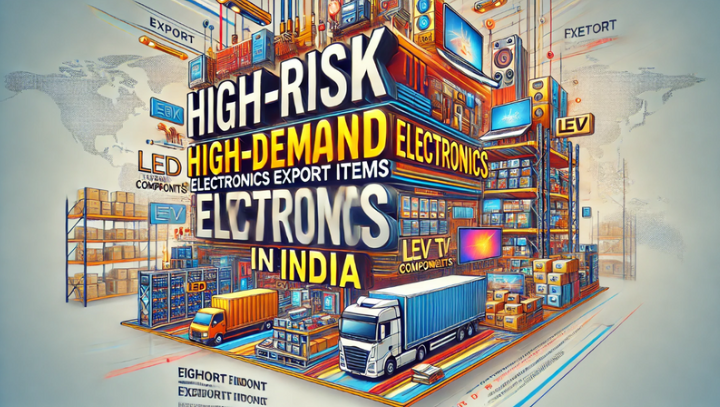AUTHOR-ELIZA FERNZ
Introduction
India has emerged as a global hub for the electronics manufacturing and export sector. With its large consumer market, growing technological prowess, and competitive labor costs, the country has become an attractive destination for both domestic and international players. However, the electronics export sector in India is not without its challenges. While the demand for certain products is high, the risks involved can be significant. This blog explores some of the high-risk, high-demand electronics export items in India, shedding light on the opportunities and challenges faced by businesses in this space.

1. Mobile Phones and Accessories
India is one of the largest mobile phone markets in the world, both for consumption and manufacturing. The demand for smartphones, feature phones, and mobile accessories such as chargers, cases, and earphones is booming. In recent years, India has also become a significant exporter of mobile phones, with several global brands manufacturing their devices in the country.
Opportunities:
- Growing Demand: With the rise of 5G, the demand for high-tech smartphones and accessories has surged.
- Competitive Manufacturing: India has made strides in mobile manufacturing through initiatives like the Production-Linked Incentive (PLI) scheme, which incentivizes manufacturers to produce in the country for both local consumption and export.
Risks:
- Supply Chain Vulnerabilities: The mobile phone industry faces several risks such as fluctuating raw material costs, dependency on imported components, and shipping delays.
- Competition from Global Giants: India faces stiff competition from China, which has established itself as the world’s largest mobile phone exporter.
2. Consumer Electronics (LED TVs, Refrigerators, and Air Conditioners)

Consumer electronics(1) are another significant export category in India. Products like LED TVs, refrigerators, washing machines, and air conditioners enjoy strong demand both domestically and internationally. India’s electronics manufacturing industry(2) has been making advancements, with several major brands outsourcing production to the country.
Opportunities:
- High Domestic Demand: With a growing middle class, the domestic market for consumer electronics is booming, driving the production and export of these products.
- Technological Advancements: Innovations such as smart TVs, energy-efficient refrigerators, and IoT-enabled appliances are creating fresh opportunities in the export market(3).
Risks:
- Import Dependency: Many high-end components such as microchips, semiconductors, and display panels are still imported, increasing the cost and vulnerability to global supply chain disruptions.
- Intense Global Competition: Countries like China and South Korea dominate the global consumer electronics market(4), making it challenging for Indian manufacturers to compete on price and technology.
3. Computer Hardware and Peripherals
India has seen a steady rise in exports of computer hardware such as processors, motherboards, and external storage devices, as well as peripherals like keyboards, mice, printers, and speakers. The demand for these products is high, driven by both the growing IT sector and a global surge in remote work.
Opportunities:
- Digital Transformation: With the global trend toward digitalization, the demand for computer hardware and peripherals has surged.
- Government Initiatives: The Indian government’s push for the Make in India and Atmanirbhar Bharat (self-reliant India) campaigns has encouraged the production of these items within the country, positioning India as a viable alternative to China.
Risks:
- Global Chip Shortage: The ongoing semiconductor shortage poses a significant risk, particularly to high-tech items such as processors and memory chips, which are essential for computing devices.
- High Import Costs: Despite progress, India still imports a significant amount of raw materials for manufacturing computer hardware, which can cause price fluctuations.
4. Telecommunication Equipment (5G Gear, Routers, and Modems)
With the rapid expansion of 5G networks globally, India has become a critical player in the telecommunication equipment export market. Companies in India are increasingly exporting 5G gear, routers, modems, and base station equipment.
Opportunities:
- 5G Revolution: India’s push for 5G adoption has positioned it as a key exporter of related infrastructure, equipment, and devices.
- Rising Global Connectivity Needs: The growth in internet penetration and demand for high-speed connectivity across developing countries also opens export avenues(5) for telecom equipment.
Risks:
- Technological Obsolescence: The rapid pace of innovation in telecommunications equipment poses a risk for manufacturers who might not keep up with the latest standards and specifications.
- Regulatory Challenges: Exporting high-tech telecom equipment requires compliance with global security standards, which can vary from country to country.

5. Electric Vehicles (EVs) and EV Components
With India moving toward a more sustainable future, electric vehicles (EVs) and related components such as batteries, chargers, and electric motors are gaining traction as high-demand export products. The government’s focus on electric mobility through incentives and subsidies is pushing this segment to the forefront.
Opportunities:
- Global Shift to Sustainability: As countries worldwide focus on reducing carbon emissions, the demand for EVs and components is rising. India’s competitive manufacturing landscape, paired with favorable policies, is attracting international attention.
- Battery and Charging Infrastructure: India is also becoming a key exporter of EV batteries and charging infrastructure, creating new export channels.
Risks:
- Supply Chain Issues: EV production heavily relies on raw materials like lithium, cobalt, and nickel, which India may have to import, exposing it to supply chain vulnerabilities.
- Technological Gaps: While India has the potential, it still lags in developing cutting-edge EV technologies compared to global leaders such as China, Europe, and the US.
Conclusion
India’s electronics export sector holds immense potential, driven by high demand in a variety of product categories such as mobile phones, consumer electronics, computer hardware, telecom equipment, and electric vehicles. However, businesses must navigate several risks, including supply chain disruptions, technological advancements, global competition, and regulatory challenges.
FAQs
1. What are the top electronics export items from India?
Mobile phones, consumer electronics (LED TVs, ACs), computer hardware, telecom equipment (5G gear), and electric vehicles (EVs) are the top export items.
2. What opportunities exist for exporting electronics from India?
Opportunities include a large domestic market, government incentives, technological advancements (like 5G and EVs), and rising global demand for sustainable tech.
3. What risks are associated with electronics exports from India?
Risks include supply chain vulnerabilities, global competition, technological obsolescence, and regulatory compliance challenges.
4. How does the semiconductor shortage impact India’s exports?
It leads to delays and increased costs, particularly for mobile phones and computer hardware, as many components are imported.
5. Why is India competitive in electronics exports?
India offers cost-effective labor, a skilled workforce, government incentives, and a large consumer market that supports high-scale production.

